
Jintang Bridge is located over Haihe River between the west end of Jianguo Road and Shuige Avenue in Tianjin. The bridge is 76.4m long and 10.5m wide. Built in 1906, it is one of the oldest large iron bridges in Tianjin and the only steel flat-turn movable bridge in China. Moreover, Jintang Bridge is also an important meeting place in the Beiping-Tianjin Campaign and a landmark building for the liberation of Tianjin. So to speak, Jintang Bridge is valuable on the sense of traffic, cultural relics and commemoration.
Steel Structure Museum has a postcard of Jintang Bridge. The postcard is 15×10cm, with a pattern of Jintang Bridge and its surroundings and "Tientsin, Austrian Bridge/Tientsin, Oesterreichische Brücke" (meaning "the Austrian Bridge in Tianjin") in English and German printed on the front. The back is printed words of "Post Card" in English and instructions for use.

Postcard of Jintang Bridge in the Steel Structure Museum
History: Jintang, A Century-old Bridge across Haihe River
Before Jintang Bridge was built, there was a local floating bridge formed by 13 wooden boats connected and paved with movable wooden boards on the surface. It was originally named Yanguan Floating Bridge, but it was also known as East Floating Bridge because it was built outside the East Gate. In the eighth year of Emperor Yongzheng in the Qing Dynasty (1730), Meng Yanzhou from the Tianjin branch of Changlu Transportation Division donated his salaries to repair the bridge to make it easier for everyone to cross the river. Hence the bridge was also called Menggong Bridge.
In order to facilitate the passage of trams, in the 31st year of the reign of Emperor Guangxu in the Qing Dynasty (1905), a joint venture was founded by Jinhai Customs and the Austrian Concession Consulate, the Italian Concession Consulate and Belgian Tram Company to build a new permanent electrically powered steel bridge with a length of 76.4m in the south of the original bridge. The bridge deck was 10m wide, with monorail tramway paved for 4m, which was later changed to a two-way dual lanes. The new bridge was completed on November 21 of the following year, and an opening ceremony was held. It cost 200,000 in silver. Due to its extremely strong structure, it was named "Jintang Bridge". Judging from the postcard in the museum, the bridge was also called "the Austrian Bridge".
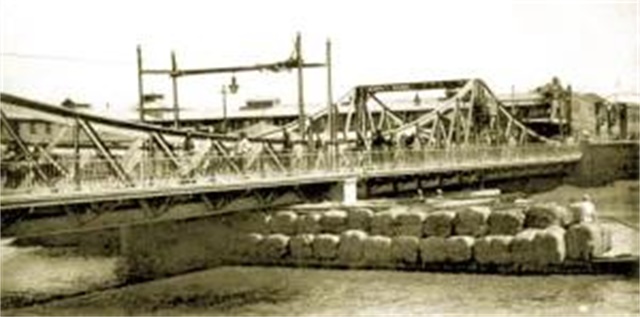
Jintang Bridge in the 1930s
After completion, Jintang Bridge underwent several renovations.
In 1934, Jintang Bridge became tilted. The Works Bureau hired a bridge engineer named Cai Junjian to take charge of repair. Because the sulfur and phosphorus contents in the steel of the original bridge far exceeded the prescribed standard and thus resulted in poor weldability, riveting and welding were combined for repair.
In 1970, the Tianjin Municipal Government repaired Jintang Bridge again. It was lifted by 1.2m. The original movable equipment was removed, and the corroded parts of the bridge were repaired and reinforced.
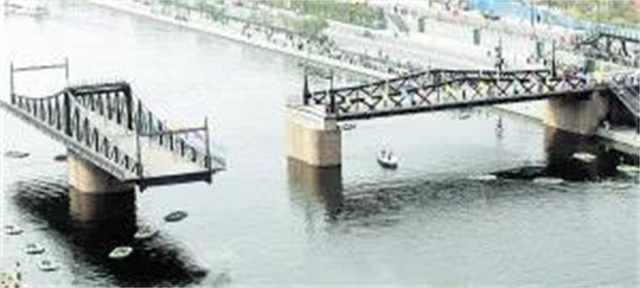
Opening scene of Jintang Bridge
In 2003, during the overall development and renovation of Haihe River, Jintang Bridge was restored to its original appearance while being reinforced and beautified. The original movable function was restored, and the navigation standards were also improved. Steel structure glass bridge approaches were added to both ends. The renovated Jintang Bridge was for pedestrians and entertainment only, while vehicles were not allowed to pass. It became a pedestrian bridge that integrated sightseeing with historical commemoration.
Commemoration: Meeting Place for Mighty Armies that Had Trudged Thousands of Miles
During the War of Liberation, Jintang Bridge witnessed the important moment of Tianjin's liberation.
In the winter of 1948, no sooner had the smoke of Liaoshen Campaign dispersed that the Northeast Field Army was ordered to march into North China, ready for Pingjin Campaign. On January 2, 1949, the Tianjin Front-line Command of the Northeast Field Army held an operation meeting. According to the characteristics of long north-south and narrow east-west terrain in Tianjin City and the defense deployment, Front-line Chief Commander Liu Yalou defined the operational strategy of "marching from east and west opposites, attacking the enemies in the middle, conquering the south before the north, cutting the enemies off before besieging them, and destroying them one by one". The meeting place for the east-west marching operation was the upper and lower reaches of Haihe River centered on Jintang Bridge.
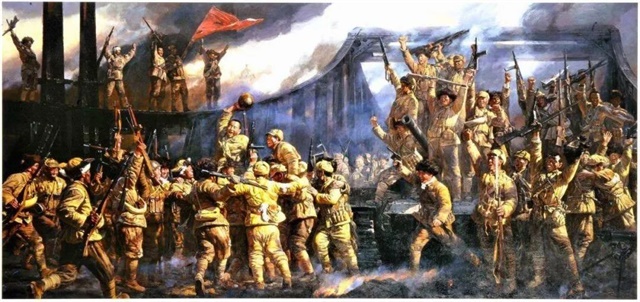
Oil painting Pingjin Campaign: Meeting at Jintang Bridge (by Sun Lixin et al.)
At 10 a.m. on January 14, 1949, the battle for the liberation of Tianjin was officially launched. The PLA dispatched 340,000 soldiers in 22 divisions of 5 armies who launched a fierce attack on the the Kuomintang's urban defense from east, south and west. After the battle started, the 38th and 39th Armies of the PLA broke through from Hepingmen and Xiyingmen and advanced from west to east. The 44th and 45th Armies broke through from Minquanmen and Minzumen and advanced from east to west. The 46th Army moved northward from Cuijia Port. There was also a division marching southward from Yixing Port. The main forces launched a converging attack from east and west, while assistance came from the north and south. The battle proceeded street by street and house by house. There was also a fierce battle before fortifications like the blockhouse near Jintang Bridge. Finally at 5:30 in the morning on January 15, the main forces from the east and west successfully joined in Jintang Bridge as planned after completing the mission of cutting off the enemies in the middle. They then began the battle of dividing and besieging the enemy forces from the south and north. The enemy forces were caught in chaos and all wiped out eventually. It took only 29 hours to liberate Tianjin in a battle and kill 130,000 enemies. On January 15, 1949, Tianjin was liberated, which in turn facilitated the peaceful liberation of Beijing and laid the foundation for the victory of Pingjin Campaign. Since then, Jintang Bridge has become a landmark building for the liberation of Tianjin. In May 1984, it was listed as a municipal cultural relics protection unit and a "patriotic education base". In 2018, it was included in the "Industrial Heritage (First Batch) List of China".
Traffic: Ingenuity Movable Design and New Beam Thanks to Technology
When Jintang Bridge was first built, its main structure was a through fully riveted steel truss. The beam was composed of different types of steel plates riveted at nodes. The top chord of the main truss had a curved shape that looked like waves from a distance, which was so designed to highlight the coastal location. The bridge had three holes, the largest of which was a fixed span with a net length of 32.8m, and the remaining two holes were flat-turn movable span with a net length of 16.85m for each. When opened, they could make a 90-degree turn to meet the clearance requirement of navigation. In the 1960s, Mr. Mao Yisheng wrote an article that commented on the movable steel bridge in Tianjin, "When the bridge is closed, cars pass on it; when it is opened, ships pass under it. The movement to allow water and land transportation makes a very economical bridge structure."
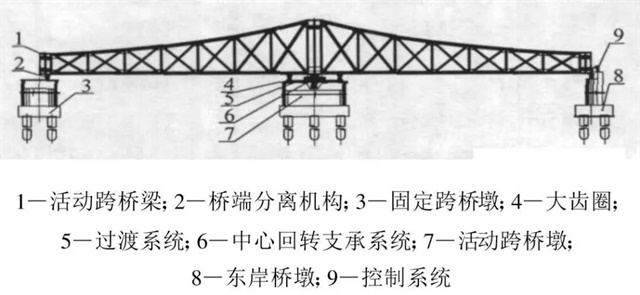
Schematic diagram of the movable span and opening system of Jintang Bridge
At first, Jintang Bridge could be opened manually and electrically. The opening process of the movable span was as follows: After pedestrians and vehicles left the movable span, the electric centralized fuel supply system was started to lubricate main support parts by adding lubricant to them, and then the four bridge-end separation mechanisms on both ends of the movable span moved upwards and stopped after hitting the limit switch. After the four separation mechanisms were separated from piers, the motor power was started or the handwheel was rotated. The movable span was flat turned on under the support of the central revolving bearing system. It took 10-12 minutes to open the bridge to 90 degrees in one stroke; to reset the bridge required reverse operations. However, according to relevant records, the bridge had completely lost the opening function by the 1930s.
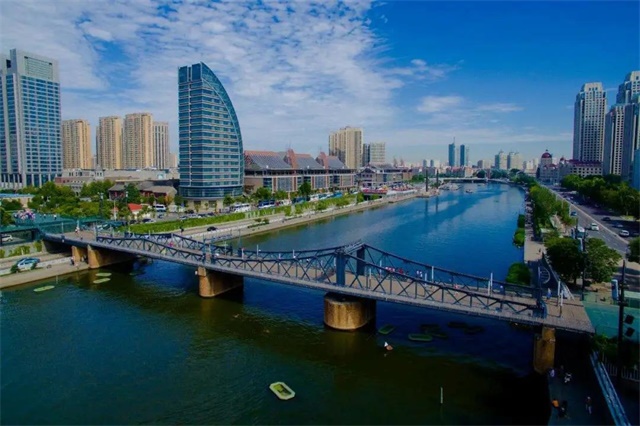
Jintang Bridge Today
In late 2002, in the Master Plan for Comprehensive Development of Haihe River, Tianjin Municipal Government planned to build Haihe into a unique economic belt, landscape belt and cultural belt. According to the overall requirements of the plan, relevant departments put Jintang Bridge under the latest reinforcement and beautification on the basis of restoring the original design: First, in terms of connection method, a new generation of riveting process was adopted, and the key joint parts were tested and inspected for their performance to confirm that the riveted connection of components had a strong overload capacity and good fatigue resistance that could meet future operating requirements; second, in the restoration and improvement of the opening system, the large friction of the original opening system, the poor positioning stability of the main bridge body, and the over-complicated design of the power system were addressed based on the principle of maintaining the original appearance by adopting a new high-strength closed rolling and rotating system, and new technologies were applied to the restoration project to fundamentally improve the opening function; third, a "bridge approach project" was added in which a sightseeing platform on the right bank, an overpass, and a boarding stair on the left bank were built and paved with glass to create a transparent and bright stereoscopic feeling, so that the ancient steel bridge and the surrounding modern buildings were harmoniously blended. The renovated Jintang Bridge becomes a pedestrian and landscape bridge that integrates tourism, sightseeing and historical commemoration as a whole and represents a unique memory of the history and style of Tianjing City.